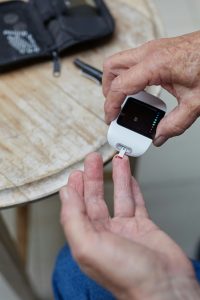Discover the intricate process of blood sugar conversion to A1C and gain insights into optimally managing your health. Learn more about Blood sugar conversion to A1c now!
Introduction
Understanding the correlation between blood sugar levels and A1C is crucial for managing diabetes effectively. This comprehensive guide delves into the nuances of blood sugar conversion to A1C, shedding light on its mechanisms and offering valuable insights for individuals striving to maintain optimal health.

Blood Sugar Conversion to A1C: Deciphering the Relationship
What is A1C and How Does it Relate to Blood Sugar?
A1C, also known as glycated hemoglobin, reflects the average blood sugar levels over the past two to three months. It measures the percentage of hemoglobin that is glycated, or coated with sugar. This provides healthcare professionals with valuable insights into long-term glycemic control, which is essential for managing conditions such as diabetes
The Significance of A1C Readings
A1C readings are more than numbers. They are vital indicators of how well diabetes is being managed. A result below 5.7% is considered normal, while a reading between 5.7% and 6.4% signals prediabetes. Any value above 6.5% may indicate diabetes, necessitating immediate attention and action.
The Importance of Regular Monitoring
Regular monitoring of A1C levels is crucial for individuals with diabetes or those at risk of developing the condition. It helps track the effectiveness of treatment plans, identify potential complications, and make necessary adjustments to lifestyle and medication. By understanding the relationship between blood sugar and A1C, individuals can take proactive steps to maintain optimal health.
Target A1C Levels
Healthcare providers typically recommend target A1C levels based on individual health status and medical history. For most people with diabetes, the target A1C is below 7%. However, this target may vary depending on factors such as age, overall health, and the presence of other medical conditions. Regular consultation with healthcare professionals can help determine personalized targets and goals.
Factors Influencing Blood Sugar Conversion to A1C
Various factors, including diet, exercise, medication adherence, and stress levels, can impact blood sugar levels and, consequently, A1C readings.
The Role of Hemoglobin in A1C Measurement
Hemoglobin, a protein found in red blood cells, undergoes glycation when exposed to glucose in the bloodstream. This process forms A1C molecules, which can be measured to assess average blood sugar levels.
Interpreting A1C Results
A1C readings provide valuable information about blood sugar control, with higher levels indicating poorer glucose management and an increased risk of diabetes-related complications.
Strategies for Managing Blood Sugar Conversion to A1C
Achieving and maintaining optimal A1C levels requires a multi-faceted approach. This may include:
- Healthy Eating: Following a balanced diet rich in fruits, vegetables, lean proteins, and whole grains can help regulate blood sugar levels and support overall health.
- Regular Exercise: Physical activity plays a crucial role in managing blood sugar levels. Engaging in regular exercise helps improve insulin sensitivity and promotes better glycemic control.
- Medication Management: For individuals with diabetes, medication adherence is essential for controlling blood sugar levels. This may include insulin injections, oral medications, or other prescribed treatments.
- Stress Management: Stress can affect blood sugar levels, so practicing relaxation techniques such as deep breathing, meditation, or yoga can be beneficial.
- Regular Monitoring: Monitoring blood sugar levels regularly, either at home or through regular medical check-ups, allows individuals to track their progress and make necessary adjustments to their treatment plan.

Gluco Tru Ancient ‘Japenese’ Mixture that Resets High Blood Sugar Click Here to Buy
Challenges in Blood Sugar Conversion to A1C
Factors such as variability in red blood cell lifespan, individual differences in glycation rates, and certain medical conditions can pose challenges in accurately interpreting A1C results.
Emerging Technologies in A1C Monitoring
Technological advancements, such as continuous glucose monitoring (CGM) systems and innovative A1C testing methods, offer promising avenues for more precise and convenient blood sugar monitoring.
Conclusion
Understanding the intricacies of blood sugar conversion to A1C empowers individuals with diabetes to take proactive steps toward better health outcomes. By incorporating lifestyle modifications, adhering to treatment plans, and staying informed about the latest advancements, managing A1C levels becomes more attainable, paving the way for a healthier and happier life.
Also Read: Sweaty scalp? Here’s what causes it and 7 ways to get rid of it
Gluco Tru Ancient ‘Japenese’ Mixture that Resets High Blood Sugar Click Here to Buy
Affiliate Disclosure:
The links contained in this product review may result in a small commission if you opt to purchase the product recommended at no additional cost to you. This goes towards supporting our research and editorial team and please know we only recommend high quality products.
Disclaimer:
Please understand that any advice or guidelines revealed here are not even remotely a substitute for sound medical advice from a licensed healthcare provider. Make sure to consult with a professional physician before making any purchasing decision if you use medications or have converts following the review details shared above. Individual results may vary as the statements made regarding these products have not been evaluated by the Food and Drug Administration. The efficacy of these products have not been confirmed by FDA approved research. These products are not intended to diagnose, treat, cure or prevent any disease.




